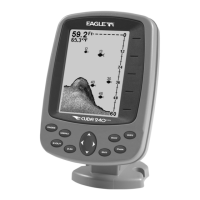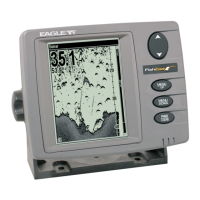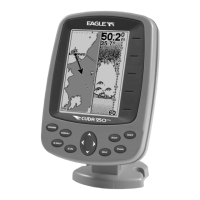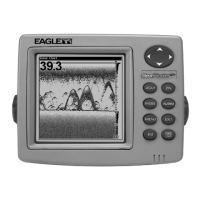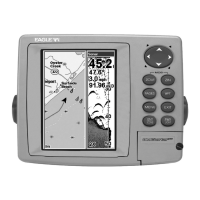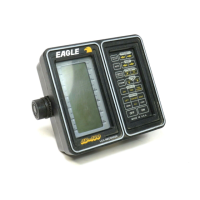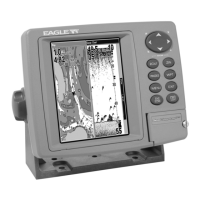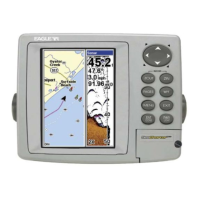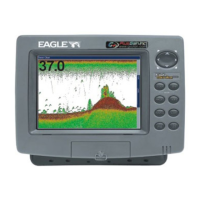Do you have a question about the Eagle Cuda 250 and is the answer not in the manual?
Details the technical specifications of the Cuda 250 S/Map unit.
Explains the basic principles of sonar technology and its application in fish finding.
Describes the fundamental operation of the GPS receiver and its navigation capabilities.
Provides background on GPS technology and the WAAS augmentation system.
Explains typographical conventions and formatting used throughout the manual.
Outlines preliminary steps and considerations before installing the sonar and GPS system.
Guides on installing the sonar transducer on various hull types.
Provides criteria for choosing the optimal mounting spot for the transducer.
Compares two common methods for mounting the transducer on a boat hull.
Details how to correctly connect the unit to a power source.
Instructions for mounting the main sonar unit using a bracket or in-dash.
Explains how to set up the unit for portable operation using a power pack.
Identifies and explains the function of each key on the unit's keypad.
Describes the unit's memory capabilities and navigation of its menu system.
A concise, step-by-step guide for basic sonar operation and features.
Provides further detail on running the sonar unit and understanding its functions.
Discusses the interpretation of fish indicators and the full sonar display.
Information on additional resources for learning sonar interpretation and features.
Explains the ASP feature for noise rejection and display optimization.
Details the setup and function of various sonar alarms like Depth, Zone, and Fish.
Covers manual and automatic sensitivity settings for optimal echo detection.
Guides on calibrating depth readings to account for transducer placement below the hull.
Explains different display modes like Full Sonar Chart and Split Zoom.
Describes how to use the built-in simulator for practicing sonar functions.
Details how to use zoom functions to enlarge specific areas of the sonar display.
Addresses problems related to the unit failing to turn on or operating in demo mode.
Provides solutions for issues like unit freezes, locks, or unpredictable behavior.
Troubleshoots common issues like weak bottom echoes, erratic readings, or missing fish signals.
Guides on identifying and minimizing electrical noise affecting sonar performance.
Explains the function of each key used for GPS navigation and operation.
Details how to turn the unit on/off and adjust screen backlight levels.
Introduces the different GPS display pages and how to navigate between them.
Information on GPS satellite lock-on, position acquisition, and signal quality.
Explains the Navigation Page, compass rose, and tracking features.
Describes how to use the Full Map Page for viewing charts and navigation data.
Guides on calculating distances from current position or between two points on the map.
Instructions for creating, deleting, and navigating to map icons.
Details on creating, saving, editing, and navigating GPS routes.
Explains how to create, save, display, and navigate trails.
Describes useful tools like Alarm Clock, Sun/Moon Calculator, and Trip Calculator.
Covers creating, saving, deleting, editing, and selecting waypoints.
Details setting up Arrival, Off Course, and Anchor alarms with distance parameters.
Explains the process of acquiring satellite lock-on and position data.
Guides on choosing display formats for position coordinates like Degrees or UTM.
Instructions for configuring map fix to find position on printed charts.
Explains how to customize data displayed on Position, Navigation, and Map pages.
Details how to use the simulator for practicing GPS navigation scenarios.
Covers options for map detail, pop-up info, filling land areas, and range rings.
Explains the importance of map datums and how to change them.
Guides on setting map display orientation to North Up, Track Up, or Course Up.
Details how to display various data types like depth, temperature, and speed on map screens.
Instructions for restoring all unit features and settings to factory defaults.
How to adjust display contrast and brightness levels for optimal viewing.
Guides on configuring units for speed, distance, depth, and temperature.
Details the technical specifications of the Cuda 250 S/Map unit.
Explains the basic principles of sonar technology and its application in fish finding.
Describes the fundamental operation of the GPS receiver and its navigation capabilities.
Provides background on GPS technology and the WAAS augmentation system.
Explains typographical conventions and formatting used throughout the manual.
Outlines preliminary steps and considerations before installing the sonar and GPS system.
Guides on installing the sonar transducer on various hull types.
Provides criteria for choosing the optimal mounting spot for the transducer.
Compares two common methods for mounting the transducer on a boat hull.
Details how to correctly connect the unit to a power source.
Instructions for mounting the main sonar unit using a bracket or in-dash.
Explains how to set up the unit for portable operation using a power pack.
Identifies and explains the function of each key on the unit's keypad.
Describes the unit's memory capabilities and navigation of its menu system.
A concise, step-by-step guide for basic sonar operation and features.
Provides further detail on running the sonar unit and understanding its functions.
Discusses the interpretation of fish indicators and the full sonar display.
Information on additional resources for learning sonar interpretation and features.
Explains the ASP feature for noise rejection and display optimization.
Details the setup and function of various sonar alarms like Depth, Zone, and Fish.
Covers manual and automatic sensitivity settings for optimal echo detection.
Guides on calibrating depth readings to account for transducer placement below the hull.
Explains different display modes like Full Sonar Chart and Split Zoom.
Describes how to use the built-in simulator for practicing sonar functions.
Details how to use zoom functions to enlarge specific areas of the sonar display.
Addresses problems related to the unit failing to turn on or operating in demo mode.
Provides solutions for issues like unit freezes, locks, or unpredictable behavior.
Troubleshoots common issues like weak bottom echoes, erratic readings, or missing fish signals.
Guides on identifying and minimizing electrical noise affecting sonar performance.
Explains the function of each key used for GPS navigation and operation.
Details how to turn the unit on/off and adjust screen backlight levels.
Introduces the different GPS display pages and how to navigate between them.
Information on GPS satellite lock-on, position acquisition, and signal quality.
Explains the Navigation Page, compass rose, and tracking features.
Describes how to use the Full Map Page for viewing charts and navigation data.
Guides on calculating distances from current position or between two points on the map.
Instructions for creating, deleting, and navigating to map icons.
Details on creating, saving, editing, and navigating GPS routes.
Explains how to create, save, display, and navigate trails.
Describes useful tools like Alarm Clock, Sun/Moon Calculator, and Trip Calculator.
Covers creating, saving, deleting, editing, and selecting waypoints.
Details setting up Arrival, Off Course, and Anchor alarms with distance parameters.
Explains the process of acquiring satellite lock-on and position data.
Guides on choosing display formats for position coordinates like Degrees or UTM.
Instructions for configuring map fix to find position on printed charts.
Explains how to customize data displayed on Position, Navigation, and Map pages.
Details how to use the simulator for practicing GPS navigation scenarios.
Covers options for map detail, pop-up info, filling land areas, and range rings.
Explains the importance of map datums and how to change them.
Guides on setting map display orientation to North Up, Track Up, or Course Up.
Details how to display various data types like depth, temperature, and speed on map screens.
Instructions for restoring all unit features and settings to factory defaults.
How to adjust display contrast and brightness levels for optimal viewing.
Guides on configuring units for speed, distance, depth, and temperature.
| Brand | Eagle |
|---|---|
| Model | Cuda 250 |
| Category | Fish Finder |
| Language | English |

